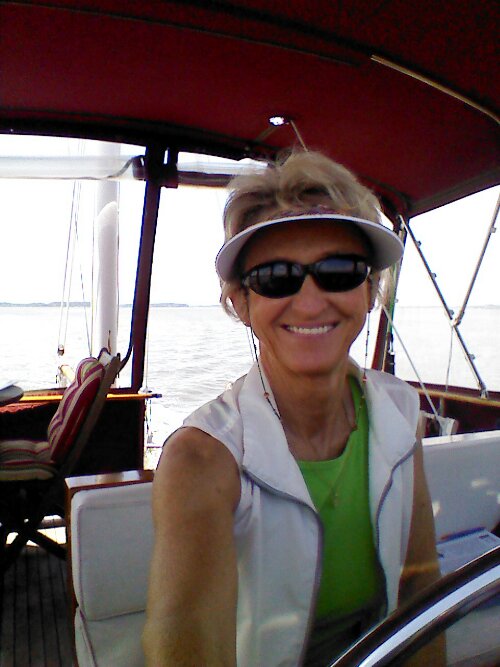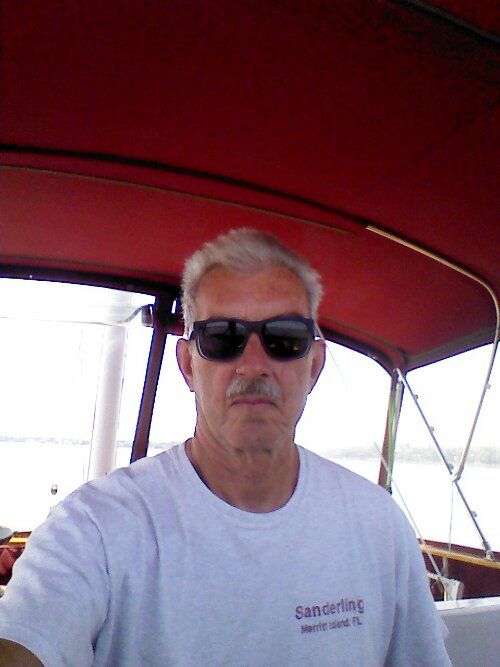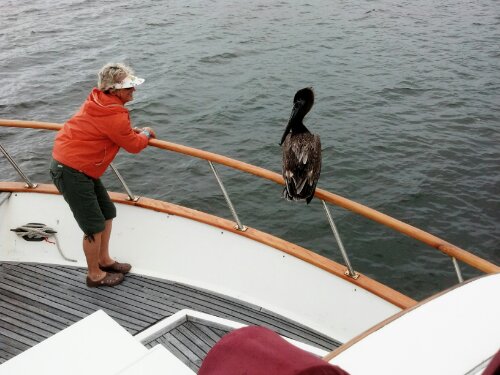On Friday, May 10th we departed Toogoodoo Creek under sunny skies, warming temperature, and light winds from the southwest. Our route continued to meander through the South Carolina low country with lots of water and salt grass marshes, punctuated here and there with land of a slightly higher elevation hosting trees – real trees (not palms). It’s always amazing to again see what a difference a foot or two of elevation can make in the type of vegetation that will grow on a hummock.
By noon we were passing through Charleston Harbor and popping out the northeast side into more low country with long straight stretches of waterway dredged through the marshes when the ICW was created in the 1930s. Again, where the spoils from the dredging were dumped, trees sprout. We continued at a good pace (7.3 miles per hour is our speed when running the engine at 1600 rpms) and ended the day at South Santee River, about 15 miles south of Georgetown, South Carolina.
Day: 76.9 statute miles – 10H05M
Trip: 518.5 statute miles – 66H5555M
Saturday was an unusual day for cruising. As we lifted anchor at 0650 the current in the South Santee River was against us until we turned northward in the ICW channel. At that point the current was pushing us and increased our speed by almost almost one mph. The unusual part is that the fair current continued with us for the entire day – into Winyah Bay, past Georgetown, South Carolina, past the Pee Dee River (original rive in Stephen Foster’s “Way Down Upon the . . . “) and Bucksport, and into Myrtle Beach (tacky, tacky, tacky). We stopped for the day at Barefoot Landing Marina in Myrtle Beach – not a great marina with absolutely no amenities except electricity and water, but it is right on the ICW and a with a few decent restaurants in the area. As we were departing Sanderling for dinner out, a huge “dredge train” came by traveling at about 3 mph southbound; it was probably 1/2 mile long, with a large tug pulling the dredge and assorted barges loaded with dredge pipes, then a second tug lashed in the middle, followed by floating dredge pipes. It was quite a site and the docks on both sides of the river were lined with spectators. We ate a relatively late dinner at Joe’s Crab Shack that evening. We have seen such “trains” several other times on the ICW and it is always an amazing site. They are so long that they have 4-6 very small tugs pushing the “train” from the sides to keep everything centered in the river.
Day: 67.7 SM – 8H30M
Trip: 586.2 SM – 75H25M
On Sunday, May 12, we departed Barefoot Landing Marina and crossed into North Carolina at Little River Inlet, then continued to the Cape Fear River (where we did not see either Roberts) where the ocean breeze of 15 mph or so was opposed to the combined river and tidal current to make a slow (5.5 mph) and bumpy ride most of the way along the 12 mile stretch until we turned off of the main channel to head through Snows Cut and into a mooring field at Carolina Beach. We’d anchored at Carolina Beach several times in the past and the holding was always problematic; this time there was a new mooring field with 10 balls, and it was perfect – no worries about dragging anchor in the middle of the night.
Day: 59.4SM – 8H30M
Trip: 645.6SM – 83H55M
The stretch of ICW from Carolina Beach to Mile Hammock Bay is notorious for it’s low bridges with opening schedules that slow down all but the smallest boats. Two of the bridges have only a 12 foot clearance (we require 15.5 feet with our mast down; 23 feet with the mast up). It’s the equivalent of having stop lights at every intersection of a major highway that are not synchronized to keep traffic moving. Consequently, with a combination of tidal currents that sometimes were fair and sometimes foul, and having to go slower than usual in order to time the arrival at the next bridge in time for an opening (or wait for an opening if arriving too soon) Monday was a slow day. We did arrive at Mile Hammock Bay at Camp LeJeune, North Carolina (the bit Marine base) leading a parade of one trawler (Sanderling) and three sailboats where we were met by four battle-ready RIBS each with about six marines heading out for games in the training area – the lead boat playing an Eric Clapton song from loud speakers! Fun! We frequently see V-22 Ospreys exercising here, but so far tonight there has been no indication that V-22s are in the area. There are ten boats anchored in the bay; we’ve been here in the past when there were 16 boats and there was still room for a few more.
Day: 52.6SM – 8H25M
Trip: 698.2SM – 92H20M
Tuesday, May 14, 2013
Departing Mile Hammock Bay heading either way requires a little coordination for boats over 12 feet in height as there are bridges that only open at certain times (on the hour and half hour, or on the hour, or at 15 and 45 past the hour). Consequently, we departed Mile Hammock Bay in order to make the northbound bridge opening at 0830 and we arrived about 5 minutes early and were joined by several sailboats before the bridge opened. The bridge tender was very kind and held the bridge open for a slower sailboat that didn’t arrive until about 0840 – very few bridge tenders are so considerate, but on the other hand there wasn’t much traffic going from the mainland to the small Marine-owned barrier island.
The ICW from Mile Hammock Bay to Moorehead City/Beaufort, North Carola, is a 25 mile stretch of the ICW that takes a broad sweep to the east along the north side of Bogue Sound. You start in a northeasterly direction and end at Moorehead city heading east for quite a few miles. The weather was calm and sunny, so the trip was easy and we arrived at Moorehead City at 1335, then turned north to pass through a long cut to the Neuse River and Oriental, North Carolina. We anchored in Smith Creek on the western side of Oriental at 1710 and after cleaning up a bit and took the dinghy to the free town dinghy dock for dinner at a local restaurant. While eating dinner the wind picked up to about 15 MPH out of the southeast, and we enjoyed a bit of a wet ride for back to the boat until we turned the corner into Smith Creek.
Day: 65.4SM – 9H10M
Trip: 763.7SM – 106H05M
We departed Oriental at 0710 on May 15th in hopes of getting through the Neuse River before the predicted higher winds kicked in mid-morning. Even then by the time we rounded Maw Point and got to Hobucken the Neuse got a little rough with 15-20 MPH wind, but the remainder of the day was in relatively protected waters until we got to the Alligator River on the north end of the Alligator-Pungo River Canal (a l-o-n-g 25 mile stretch). By the end of the canal the wind had picked up to 15-20 with higher gusts from the SW. We anchored in the lee of a strip of land that jutted out into the river along with two sailboats and another trawler.
Day: 84.9SM – 11H00M
Trip: 846.6SM – 117H-5M



